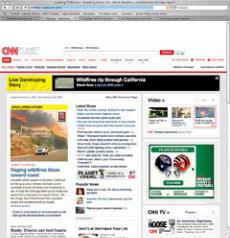 Screengrab by Glenn Connelly / Photo Editor
Screengrab by Glenn Connelly / Photo Editor“Unedited. Unfiltered. News.”These are not the words most associate with a CNN company. But that changed on Feb. 13 with the launch of a new citizen journalism Web site by the Atlanta-based media company. On Feb. 11, CNN announced it would add one more event to the timeline of citizen journalism with a completely new Web site aimed at gathering photos and videos from viewers of CNN and visitors of www.CNN.com. The new iReport focuses entirely on user-generated content similar to YouTube. However, unlike the previous iReport, edited by hands of CNN staff, users can now rate and comment on news clips, as well as search for specific news topics.Launched in 2006, CNN was the first major news network to begin accepting photos and videos from viewers through online submissions and via cell phone. So-called “iReporters” can send in their views of a breaking news story and can have their images, videos and testimonials distributed on CNN broadcasts.While Web sites such as iReport are nothing new, recent events have brought them to people’s attention.In April 2007, the first images from the Virginia Tech massacre came from a graduate student who sent a camera phone video to CNN’s iReport e-mail account. It was the first time viewers got a chilling look into the madness of such an event, and it demonstrated how quickly one can send information from cell phones. During the October 2007 wildfires in Southern California, CNN received more than 11,000 iReports of people’s views about the catastrophe. These events showed CNN’s parent company Time Warner Inc., the potential of user-generated news during a time of crisis. Jim Walton, president of CNN Worldwide said audience participation is a natural extension of news, according to Media Week.CNN Headline News even has a weekly iReport-generated show called “News To Me” – a sign of the program’s success. However, of the 100,000 iReport submissions sent to CNN iReport, less than 10 percent actually appeared on CNN or its Web site, Time Warner said in a recent press release. In response, the iReport Web site said, “One of the goals of this site is to expand the current definition to news.” CNN hopes to make all of the submitted iReport content available.Recreation junior Mike Noce said he doesn’t think the definition of news will change with the new site, but it will be helpful in addition to professional reporting.”That’s more like people’s lives, it’s not the media” Noce said. “Part of it will be from somebody’s hands.”On iReport, users ages 13 or older can submit pictures, video and text via Internet or cell phone. Other users rate content on its timeliness, quality and newsiness. Content that’s not considered news won’t be removed from the site unless it breaches the Web site’s community guidelines, which include the posting of copyrighted material or obscenity.iReports that are selected by CNN staff to air will have an “On CNN” stamp and can be used by the company at its discretion.Noce said this platform has its pitfalls in certain situations. “People will do anything for money and fame,” he said. “I don’t think it sends the right message to everyone else. My first intention, if somebody is in danger, is not to pull out a camera, but go help the person.”Some critics, even popular iReporters, have already derided the site as the “most trusted name in news” for focusing too much on user moderation of content, and its lack of credibility and ethics.The next major news event, no matter the magnitude, will show how useful CNN’s new product is, and whether it will be a major player in the news of the future.









